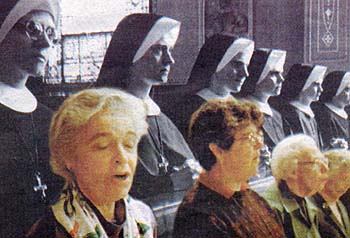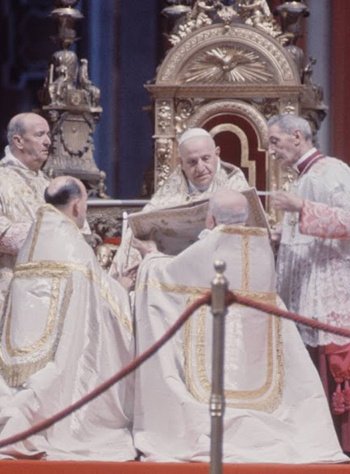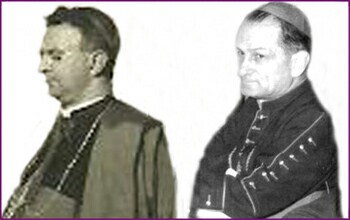Consequences of Vatican II
 |
 |
 |
 |
 |
 |
 |
The Progressivist Sect & Vatican II – Part III
Vatican II Endorsed the French Revolution &
Refused to Condemn Communism
The voluminous Pastoral Constitution Gaudium et spes of Vatican II describes with “joy and hope” (GS 1) the world of its time, 1965.
This declaration expresses how the relations between Church-Society and Church-State are conceived according to the criteria of the Progressivist Sect. The subject can be summarized in the following points:
 Along these same lines, the Declaration Dignitatis humanae affirms: “It is manifest that all nations are coming into ever closer unity. Men of different cultures and religions are being brought together in closer relationships. …
Along these same lines, the Declaration Dignitatis humanae affirms: “It is manifest that all nations are coming into ever closer unity. Men of different cultures and religions are being brought together in closer relationships. …
“Consequently, in order that relationships of peace and harmony be established and maintained within the whole of mankind, it is necessary that religious liberty be everywhere protected by an effective constitutional guarantee and that respect be shown for the supreme duty and right of man to freely lead his religious life in society.” (DH 15)
Analogously, the Declaration Nostra aetate affirms: The Catholic Church, “in her task of of promoting unity and love among men, indeed among nations, considers above all in this declaration what men have in common and what draws them to fellowship.” (NA 1)
Endorsing the world born from the French Revolution
The optimistic opening speech of the Council, delivered on October 11, 1962, in Latin by John XXIII at St. Peter’s Basilica, emphasized a “predominantly pastoral magisterium,” censured the “prophets of gloom” who in modern times “are always forecasting disaster,” and defined the spirit of the Council with the polyvalent terms aggiornamento and modernization. (1)
 The Council was seduced by the word pastoral, applied in a way that would re-think the whole history of the Catholic Church from a pastoral or apostolic perspective. Other talismanic nouns such as peace, dialogue, ecumenism and reform were used to reach a similar end.
The Council was seduced by the word pastoral, applied in a way that would re-think the whole history of the Catholic Church from a pastoral or apostolic perspective. Other talismanic nouns such as peace, dialogue, ecumenism and reform were used to reach a similar end.
Those words were applied to reflect a mentality that incontestably opposed the militant nature of the 20 previous ecumenical councils turned toward the condemnation of heresies and errors against the Catholic Faith. Thus, with an unorthodox intent and purpose, the term pastoral was adopted in the title of the Pastoral Constitution Gaudium et spes of Vatican II.
Paul VI called this document “the encounter of the Church with the modern world.” (2)
This description was confirmed in 1967 by Card. Joseph Ratzinger who stated:
This adaptation, by the way, is perfectly expressed by the terms Modernism and Progressivism.
Thus, Vatican II baptized the contemporary world born from the Revolution of 1789 without its repentance or conversion. In short, the Council was nothing less than the greatest historic calamity of authentic Christianity.
The Council not only blessed the social and political errors of the French Revolution, but gave an official endorsement to the bad tendencies of Catholic Action, which was criticized by Prof. Plinio Corrêa de Oliveira in 1943. We have already summarized the basic principles that oriented Catholic Action in previous articles (here & here).
Refusal to condemn Communism
Vatican II avoided making any clear condemnation of Marxism, Socialism and Communism, breaking with the preceding Magisterium. This omission alone would suffice to disqualify it from its pretense to be “pastoral.” Indeed, History cannot judge it to have any genuinely pastoral intent when the principal error of the 20th century was not addressed.
Some vague, indirect and insufficient references to Atheism were made, such as:
 The deliberate omission of condemning Communism at the Council has a sad history. Three important initiatives were taken by the conciliar Fathers asking the Pope and the Council to condemn Communism.
The deliberate omission of condemning Communism at the Council has a sad history. Three important initiatives were taken by the conciliar Fathers asking the Pope and the Council to condemn Communism.
On November 3, 1963, Bishop Antonio de Castro Mayer presented to the Secretary of State, Card. Amleto Cicognani, a petition signed by 218 Bishops from 54 countries asking the Pope and the Council to again condemn Marxism, Socialism and Communism and to warn the faithful about these ideologies of the Totalitarian State.
On February 3, 1964, Archbishop Geraldo de Proença Sigaud personally delivered to Paul VI in a private audience a second petition signed by 510 Prelates from 78 countries. They asked the Council to consecrate Russia and the other nations under the dominium of Communism to the Immaculate Heart of Mary in accordance with the request of Our Lady in Fatima on July 13, 1917. (4)
On October 9, 1965, Archbishop Geraldo Sigaud and Archbishop Marcel Lefebvre - supported by 334 signatures of conciliar Fathers, to which another 101 were later added - delivered to the General Secretariat of the Council, Archbishop Gabriel Garonne, the third collective request to condemn Communism. It made this demand: “A new paragraph must be added to the Constitution Gaudium et spes to deal expressly with the problem of Communism.” (5)
These three petitions were not taken into consideration, and the final text of Gaudium et spes was approved on December 7, 1965, without that requested addition.
Unfortunately, the rejection of those petitions confirmed the rumors circulating in the high ecclesiastical cupolas that an accord had been reached between Rome and Moscow not to condemn Communism. Today, those commentaries have proved to be true, and that accord is an indisputably known fact.
We refer to the “Pact of Metz” (France) made on August 18, 1962, with Card. Eugène Tisserand representing the Holy See and Metropolitan Nikodin, a known KGB agent, representing the Russian Schismatic Church, Both agreed upon the conditions for the Russian Schismatics to be present in the Council as observers: They would accept John XXIII’s invitation only if Communism were neither condemned nor mentioned. (6)
In final analysis, Vatican II tacitly accepted the pacific coexistence of the Catholic Church with the communist regimes and parties. We will return in another article to take a closer look at this matter.
To be continued

This declaration expresses how the relations between Church-Society and Church-State are conceived according to the criteria of the Progressivist Sect. The subject can be summarized in the following points:
- The Council desires to explain to all how it conceives the presence and action of the Church in today’s world. “The world,” it states, “had fallen into the bondage of sin, yet emancipated now by Christ who broke the stranglehold of evil personified.” (GS 2)
- The Catholic Church “exists in this world, living and acting with it.” (GS 40)
- The Church is “in dialogue with the world” (GS 43) and this must be a “mutual dialogue.” (GS 40)
- “Christians cannot yearn for anything more ardently than to serve the men of the modern world.” (GS 93)
- “The Church recognizes that worthy elements are found in today’s social movements, especially an evolution toward unity.” (GS 42)
- “The promotion of unity belongs to the innermost nature of the Church.” (GS 42)

Responding to the Council, sisters left off their habit to join the modern world
“Consequently, in order that relationships of peace and harmony be established and maintained within the whole of mankind, it is necessary that religious liberty be everywhere protected by an effective constitutional guarantee and that respect be shown for the supreme duty and right of man to freely lead his religious life in society.” (DH 15)
Analogously, the Declaration Nostra aetate affirms: The Catholic Church, “in her task of of promoting unity and love among men, indeed among nations, considers above all in this declaration what men have in common and what draws them to fellowship.” (NA 1)
Endorsing the world born from the French Revolution
The optimistic opening speech of the Council, delivered on October 11, 1962, in Latin by John XXIII at St. Peter’s Basilica, emphasized a “predominantly pastoral magisterium,” censured the “prophets of gloom” who in modern times “are always forecasting disaster,” and defined the spirit of the Council with the polyvalent terms aggiornamento and modernization. (1)

Opening the council with optimistic tones stressing its pastoral nature
Those words were applied to reflect a mentality that incontestably opposed the militant nature of the 20 previous ecumenical councils turned toward the condemnation of heresies and errors against the Catholic Faith. Thus, with an unorthodox intent and purpose, the term pastoral was adopted in the title of the Pastoral Constitution Gaudium et spes of Vatican II.
Paul VI called this document “the encounter of the Church with the modern world.” (2)
This description was confirmed in 1967 by Card. Joseph Ratzinger who stated:
- “After the denials of the last hundred years, the Council took the initiative of opening this process of accepting the positive encounter of the Church with the modern world.”
- “The fight of the conciliar Fathers over Schema XIII (Gaudium et spes) is necessarily just the beginning of a movement that continues.” (3)
This adaptation, by the way, is perfectly expressed by the terms Modernism and Progressivism.
Thus, Vatican II baptized the contemporary world born from the Revolution of 1789 without its repentance or conversion. In short, the Council was nothing less than the greatest historic calamity of authentic Christianity.
The Council not only blessed the social and political errors of the French Revolution, but gave an official endorsement to the bad tendencies of Catholic Action, which was criticized by Prof. Plinio Corrêa de Oliveira in 1943. We have already summarized the basic principles that oriented Catholic Action in previous articles (here & here).
Refusal to condemn Communism
Vatican II avoided making any clear condemnation of Marxism, Socialism and Communism, breaking with the preceding Magisterium. This omission alone would suffice to disqualify it from its pretense to be “pastoral.” Indeed, History cannot judge it to have any genuinely pastoral intent when the principal error of the 20th century was not addressed.
Some vague, indirect and insufficient references to Atheism were made, such as:
- “Atheism results not rarely from a violent protest against the evil in this world” (GS 19)
- “Faithful to God and men, the Church has already repudiated and cannot cease repudiating, sorrowfully but as firmly as possible, those poisonous doctrines and actions that contradict reason and the common experience of humanity and dethrone man from his innate excellence.” (GS 21)
- “The Church sincerely professes that all men, believers and non-believers alike, ought to work for the rightful betterment of this world in which all alike live. … Hence the Church protests against the distinction which some state authorities make between believers and non-believers with prejudice to the fundamental rights of the human person. She calls for the active liberty of believers to build up, in this world the temple of God.” (GS 21)

Archbishop Sigaud, left, and Bishop Mayer presented the three Petitions against Communism at the Council, the last one accompanied by Archbishop Lefebvre
On November 3, 1963, Bishop Antonio de Castro Mayer presented to the Secretary of State, Card. Amleto Cicognani, a petition signed by 218 Bishops from 54 countries asking the Pope and the Council to again condemn Marxism, Socialism and Communism and to warn the faithful about these ideologies of the Totalitarian State.
On February 3, 1964, Archbishop Geraldo de Proença Sigaud personally delivered to Paul VI in a private audience a second petition signed by 510 Prelates from 78 countries. They asked the Council to consecrate Russia and the other nations under the dominium of Communism to the Immaculate Heart of Mary in accordance with the request of Our Lady in Fatima on July 13, 1917. (4)
On October 9, 1965, Archbishop Geraldo Sigaud and Archbishop Marcel Lefebvre - supported by 334 signatures of conciliar Fathers, to which another 101 were later added - delivered to the General Secretariat of the Council, Archbishop Gabriel Garonne, the third collective request to condemn Communism. It made this demand: “A new paragraph must be added to the Constitution Gaudium et spes to deal expressly with the problem of Communism.” (5)
These three petitions were not taken into consideration, and the final text of Gaudium et spes was approved on December 7, 1965, without that requested addition.
Unfortunately, the rejection of those petitions confirmed the rumors circulating in the high ecclesiastical cupolas that an accord had been reached between Rome and Moscow not to condemn Communism. Today, those commentaries have proved to be true, and that accord is an indisputably known fact.
We refer to the “Pact of Metz” (France) made on August 18, 1962, with Card. Eugène Tisserand representing the Holy See and Metropolitan Nikodin, a known KGB agent, representing the Russian Schismatic Church, Both agreed upon the conditions for the Russian Schismatics to be present in the Council as observers: They would accept John XXIII’s invitation only if Communism were neither condemned nor mentioned. (6)
In final analysis, Vatican II tacitly accepted the pacific coexistence of the Catholic Church with the communist regimes and parties. We will return in another article to take a closer look at this matter.
- L’ Osservatore Romano, October 12, 1962, p. 3.
- Compêndio Vaticano II, Vozes, Petrópolis, 18° ed., 1986, p. 142
- Joseph Ratzinger, Problemi e risultati del Concilio Vaticano II, Queriniana, Brescia, 1967, pp. 10-11, 70
- Roberto de Mattei, Uma História nunca Escrita, Editora Caminhos Romanos, Porto, pp. 312-314
- Ibid, pp. 428-436
- Padre Paul Kramer, O Derradeiro Combate do Demônio, Associação Missionária Coimbra, 2003, pp. 49 a 51. 75

Posted December 16, 2013
______________________
______________________














